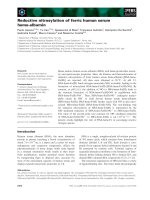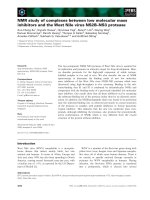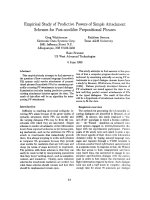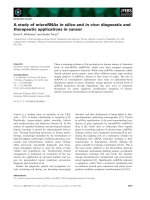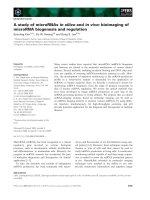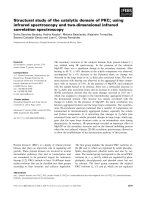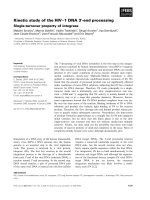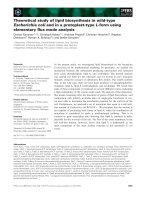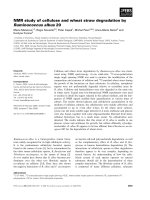Báo cáo khoa học: " Immunohistochemical Study of the Endocrine Cells in the Pancreas of the Carp, Cyprinus carpio (Cyprinidae)" docx
Bạn đang xem bản rút gọn của tài liệu. Xem và tải ngay bản đầy đủ của tài liệu tại đây (748.24 KB, 12 trang )
J O U R N A L O F
Veterinary
Science
J. Vet. Sci. (2002), 3(4), 303-314
Abstract
8)
The regional distribution and relative frequency of
some endocrine cells in the pancreas of the carp,
Cyprinus carpio
Linnaeus, belonging to the family
Cyprinidae in the order Cypriniformes, were observed
using specific mammalian antisera against insulin,
glucagon, somatostatin and human pancreatic poly-
peptide (hPP) by peroxidase antiperoxidase (PAP)
method. The pancreas w as divided into four regions
(principal and secondary islets, exocrine and pancreatic
duct regions). In addition, the pancreatic islet regions
w ere further subdivided into three regions (central,
mantle and peripheral regions) and the pancreatic
duct regions w ere subdivided into two regions
(epithelial and subepithelial regions). Spherical to
spindle or occasionally round to oval shaped immuno-
reactive (IR) cells were demonstrated in the pancreatic
islets, exocrine and pancreatic duct. In the principal
islet regions, some cells w ere also detected in the other
regions, most of insulin- and somatostatin-IR cells were
located in the central regions, and glucagon- and
hPP-IR cells w ere situated in the peripheral regions.
In this regions, insulin-IR cells were most predominant
cell types and then, glucagon, somatostatin and hPP in
that order. In the secondary islet regions, the regional
distribution and relative frequency of these four
types of endocrine cells w ere quite similar to those of
the principal islets except for cell clusters consisted
of hPP-IR cells that were situated in the peripheral to
mantle regions. In the pancreatic duct regions, all
four major pancreatic endocrine cells were demonstrated
in the inter-epithelial cells and/or basal regions of the
epithelial linning. In addition, cell clusters com posed
*
Corresponding author: Dr. Jae-Hyun Lee
Laboratory of Histology, College of Veterinary Medicine, Kyungpook
National University, Taegu 702-701, Korea
Tel : +82-53-950-5970, Fax : +82-53-950-5955
E-mail :
of n um erou s insulin-, m ode rate glucagon- and
somatostatin-IR cells of low frequency w ere also
observed in the subepithelial regions of the pancreatic
duct. In the exocrine regions, insulin-, glucagon-,
somatostatin- and hPP-IR cells were located in the
inter-acinus regions w ith rare, a few, moderate and
moderate frequencies, respectively. In conclusion, the
regional distribution and relative frequency of four
major pancreatic endocrine cells, insulin-, glucagon-,
somatostatin- and hPP-IR cells, in the pancreas of the
carp showed general patterns w hich w ere observed in
other stomachless te leost. However, some species-
dependent different distributional patterns and/or
relative frequencies were also demonstrated.
Key w ords :
Carps, pancreas, hepatopancreas, immuno-
histochemistry, immunoreactive cells, endocrine cells
Introduction
The carp, Cyprinus carpio Linnaeus, belonging to the
family Cyprinidae in the order Cypriniformes is a fresh-
water stomachless teleost. Although this species was originated
from Asia, now their habitation is distributed throughout
the world except for some regions of South America and
Australia. Among teleost, the pancreas of this stomachless
teleost has been widely studied because their unique anatomical
and histological profiles, so called hepatopancreas in there,
pancreas was dispersed throughout the whole liver parenchyma,
of course some pancreatic parenchyma having large islets
was also demonstrated between liver and mesenteric membrane
[21].
It is generally known that pancreas of vertebrates is
subdivided into two regions. One is an exocrine region
where digestive enzymes are released and the other is an
endocrine portion where regulatory hormones such as insulin,
glucagon, somatostatin and pancreatic polypeptide (PP) are
released into blood vessels. The appearance, regional distribution
and relative frequency of these regulatory hormones secreted
by endocrine cells in the pancreas are well recognized by
Immunohistochemical Study of the Endocrine Cells in the Pancreas of the Carp,
Cyprinus carpio (Cyprinidae)
Hee-Sun Kong, Jae-Hyun Lee*, Ki-Dae Park, Sae-Kwang Ku1 and Hyeung-Sik Lee2
Laboratory of Histology, College of Veterinary Medicine, Kyungpook National University, Taegu 702-701, Korea
1Pharmacology & Toxicology Lab., Central Research Laboratories, Dong-Wha Pharm. Ind. Co., Anyang 430-017, Korea
2Department of Biology, Faculty of Natural Science Kyungsan University, Kyungsan 712-240, Korea
Received July 4, 2002 / Accepted November 21, 2002
304 Hee-Sun Kong, Jae-Hyun Lee, Ki-Dae Park, Sae-Kwang Ku and Hyeung-Sik Lee
histochemistry [28], immunofluorescence method [39] and
immunohistochemistry [52]. In addition to four regulatory
hormones mentioned above, peptide YY-, neuropeptide Y-
[2], and chromogranin family- [22, 43] immunoreactive (IR)
cells were also demonstrated in the vertebrate pancreas.
The pancreas has been treated as a valuable organ for
endocrine studies and endocrine pancreas was extensively
studied associated with diabetes [23]. Until now, investigations
of gastroenteropancraetic (GEP) endocrine cells have been
considered to be an important part of a phylogenetic study
[11] and the distribution and relative frequency of these
endocrine cells in the pancreas were varied with animal
species and feeding habits. Recently most intensive studies
have been done on the Pisces because some endocrine cells
were demonstrated in the skin, gills and airways [58], and
the alteration of regional distribution and relative frequency
of these cells by heavy metal intoxication such as lead was
also demonstrated [41]. In addition, the possibility of using
the teleost fish endocrine tissues for treatment hormonal
disorder such as diabetes was suggested [37]. The endocrine
pancreas of teleost fish is mainly composed of two types of
pancreatic islets: 1) one, two or even more multiple large
islets, called principal pancreatic islets and 2) numerous,
widely scattered small islets, called secondary pancreatic
islets [14]. Until now, the appearance, regional distribution
and relative frequency of numerous types of regulatory
peptides have been demonstrated in the pancreas of the
Pisces. Insulin-, glucagon-, somatostatin- and pancreatic
polypeptide (PP)-IR cells, which were major four endocrine
cell types detected in mammalian pancreas, were also
observed in the pancreas of the five species of Osteo-
glossomorpha [3, 4], the gar [16], the southern-hemisphere
lampreys [56], the sea bream [1], the lamprey [7, 8], the sea
bass [35], the dipnoan fish [47], the cartilaginous fish [15],
the rainbow trout [38], the coho salmon [38], the arctic
lamprey [57], the anglerfish [24], the channel catfish [24],
the ray [48] and the telecostei [27] by immunohistochemical
and/or electron microscopical methods. In addition, similar
to that of mammals, the appearance of neuropeptide Y and
peptide YY-IR cells and/or nerve fibers was also demon-
strated in the pancreas of the eel [12], the dogfish [9, 10]
and the spiny dogfish [40]. The ontogenic changes and
changes of distribution and relative frequency of some
endocrine cells with developmental stages were also well
documented in the Japanese flounder [29], the dogfish [9],
the lamprey [13], the sea bream [46] and the sea bass [5].
Well corresponding to those of mammals, the regional
distribution and relative frequency of endocrine cells within
the pancreas, and the cell population seemed to be con-
siderably variable among species and feeding habits, especially
in the case of occurrence in PP cells [55]. Namely, these IR
cells that were generally demonstrated in teleost, were not
detected in the pancreas of channel catfish and lungfish [18,
36]. In addition, it is also reported that somewhat different
distributional patterns of pancreatic endocrine cells were
found in two species of stomach fresh water teleost having
similar feeding habits [34]. Although many studies have
elucidated regional distribution and relative frequency of
endocrine cells, IR to the antisera against mammalian insulin,
glucagon, somatostatin and PP, in the pancreas of teleost,
localization of endocrine cells on the pancreas of the carp
has not yet been reported except for insulin. Regulation of
insulin biosynthesis was reported in the carp [20] and the
carp insulin was isolated and crystallized [42].
In the present study, the regional distribution and
relative frequency of some endocrine cells in the pancreas of
stomachless fresh-water teleost, the carp, Cyprinus carpio
Linnaeus (Cyprinidae) having unique hepatopancreas, were
observed using specific antisera against mammalian insulin,
glucagon, somatostatin and PP by peroxidase antiperoxidase
(PAP) method.
Materials and Methods
Experim ental animals
Five adult carp, Cyprinus carpio Linnaeus (Cyprinidae),
about 40cm in length, were purchased from a merchant in
Taegu, Korea and used in this study without sexual
distinction.
Histological procedures
After decapitation, samples from the pancreas were fixed
in Bouin's solution. After paraffin embedding, 3
~
4
㎛
sections
were prepared. Representative sections of each tissue were
stained with hematoxylin and eosin for light microscopic
examination of the normal pancreatic architecture.
Immunohistochemical procedures
The each representative section was deparaffinized,
rehydrated and immunostained with the peroxidase anti-
peroxidase (PAP) method [51]. Blocking of nonspecific
reaction was performed with normal goat serum prior to
incubation with the specific antisera (Table 1). After rinsed
in phosphate buffered saline (PBS; 0.01M, pH 7.4), the
sections were incubated in secondary antiserum. They were
then washed in PBS buffer and finally the PAP complex
was prepared. The peroxidase reaction was carried out in a
solution 3,3
′
-diaminobenzidine tetrahydrochloride containing
0.01% H2O2 in Tris-HCl buffer (0.05M, pH 7.6). After
immunostained, the sections were lightly counterstained
with Mayer's hematoxylin and the IR cells were observed
under light microscope
Specificity of antiserum reaction
The specificity of each immunohistochemical reaction was
determined as recommended by Sternberger [51], including
the replacement of specific antiserum by the same antiserum,
which had been preincubated with its corresponding antigen.
Immunohistochemical Study of the Endocrine Cells in the Pancreas of the Carp, Cyprinus carpio (Cyprinidae) 305
Category of relative frequency
The relative frequency of occurrence of each type of IR
cell was placed into one of five categories, not detected (
—
),
rare (
±
), a few (+), moderate (++) and numerous (+++),
according to their observed numbers as seen using light
microscopy.
Classification of pancreatic regions
The distribution of IR cells was divided into four regions,
1) the principal and 2) secondary islets regions, 3) the
exocrine regions and 4) pancreatic duct regions according to
modified classifications of Lee et al. [34] and Ku et al. [32]
which were classified by their histological profiles. In addition,
the regional distribution and relative frequency of endocrine
cells in the pancreatic islets were further subdivided into
three regions from centrally to marginally, central, mantle
and peripheral regions according to types of cell composition.
The pancreatic duct regions were also subdivided into two
distinct regions according to their histological profiles, epithelial
lining and sub-epithelial regions.
Results
In the present study, all four kinds of the IR endocrine
cells were detected using antisera against mammalian
insulin, glucagon, somatostatin and hPP in the pancreatic
islets, pancreatic duct and exocrine regions. Different
regional distributions and relative frequencies of these IR
cells were observed in the different pancreatic regions, and
these differences are shown in Table 24. Spherical to spindle
or occasionally oval to round-shaped immunoreactive cells
were observed in this study.
Insulin-IR cells
In the principal pancreatic islets, spherical to spindle
shaped cells having cytoplasmic process were demonstrated
in the central regions with numerous frequencies but they
were situated in the mantle regions with a few frequencies
and no cells were found in the peripheral regions. In there,
their cytoplasmic processes were intermingled with other IR
cells especially with somatostatin-IR cells (Figs. 2ac). In the
pancreatic duct, spindle shaped insulin-IR cells were
detected in the inter-epithelial cells of duct epithelium with
a few frequencies (Figs. 2df) and some cells were located in
the basal regions of the pancreatic duct epithelial lining. In
addition, insulin-IR cells were also located in the cell clusters
situated in the sub-epithelial regions in the case of large
pancreatic ducts (Figs. 2d and e) with moderate frequency.
In the secondary islet regions, they were mainly located in
the central regions with similar shape compared to that of
principal islets and showing numerous frequencies. In addition,
some cells were also demonstrated in the mantle regions in
there their cytoplasmic processes were intermingled with
other endocrine cells especially glucagon-IR cells and showing
rare frequency. However, no insulin-IR cells were found in
the peripheral regions (Fig. 2g). In the exocrine regions,
round to oval shaped insulin-IR cells were detected between
acinar cells with rare frequencies (Fig. 2h).
Table 2
. Regional distribution and relative frequency of
the endocrine cells in the principal pancreatic
islets of the carp
Hormones
Regions of principal pancreatic islets
Central Mantle Peripheral
Insulin
Glucagon
Somatostatin
hPP*
+++
±
++
±
+
+
+
±
+
+
±
+
—
: not detected,
±
: rare,
+
: a few,
++
: moderate and
+++
: numerous.
*hPP : human pancreatic polypeptide.
Glucagon-IR cells
In the principal pancreatic islets, spherical to spindle
shaped cells having cytoplasmic process were demonstrated
in the peripheral regions with moderate frequency and some
of these IR cells were situated in the mantle and central
regions with a few and rare frequencies respectively. In
there, their cytoplasmic processes were intermingled with
other IR cells especially with insulin-IR cells (Figs. 3ad). In
the pancreatic duct, spindle shaped glucagon-IR cells were
detected in the inter-epithelial cells of duct epithelium with
moderate frequency (Figs. 3eg), and some cells were located
Table 1.
Antisera used in this study
Antisera* Code Source Dilution
Insulin
Glucagon
Somatostatin
HPP1)
842613
927604
917600
A61P
Diasorin, Stillwater, USA
Diasorin, Stillwater, USA
Diasorin, Stillwater, USA
DAKO Corp., Carpenteria, USA
1:1,000
1:2,000
1:600
1:100
*All antisera were raised in rabbits except for insulin, which were raised in a guinea pig.
1) hPP: human pancreatic polypeptide
306 Hee-Sun Kong, Jae-Hyun Lee, Ki-Dae Park, Sae-Kwang Ku and Hyeung-Sik Lee
Fig. 2.
Insulin-IR cells in the pancreas of the carp. Note that these IR cells were dispersed throughout whole central regions
of the principal islets and the cells of lower frequncy were also demonstrated in the mantle regions (a, b). In the pancreatic
duct, they were located in the inter-epithelial cells or basal regions of epithelial lining (df). In addition, insulin-IR cells were
also detected in the cell clusters located in the sub-epithelial regions of the large types of pancreatic duct (d, e). The regional
distribution of insulin-IR cells in the secondary islets was quite similar to those of the principal islets (g). Some cells were
also demonstrated in the inter-acinus regions of the exocrine regions (h) that were dispersed between liver parenchyma (L).
a, b:
×
120; ce, g:
×
240; f, h:
×
480. PAP method.
Immunohistochemical Study of the Endocrine Cells in the Pancreas of the Carp, Cyprinus carpio (Cyprinidae) 307
Fig. 3.
Glucagon-IR cells in the pancreas of the carp. Note that most of glucagon-IR cells were restricted to the peripheral
and mantle regions of the principal islets and the cells of low frequency were also demonstrated in the central regions (ad).
In the pancreatic duct, they were located in the inter-epithelial cells or basal regions of epithelial lining (e, f). In addition,
some cells were also detected in the cell clusters located in the sub-epithelial regions of the large types of pancreatic duct
(g). The regional distribution of glucagon-IR cells in the secondary islets was quite similar to those of the principal islets
(h). Glucagon-IR cells were also observed in the inter-acinus regions of the exocrine regions (i). a, b:
×
120; ch:
×
240; i:
×
480.
PAP method.
308 Hee-Sun Kong, Jae-Hyun Lee, Ki-Dae Park, Sae-Kwang Ku and Hyeung-Sik Lee
in the basal regions of the pancreatic duct epithelial lining.
In addition, glucagon-IR cells were also located in the cell
clusters situated in the lamina propria regions in the case
of large pancreatic ducts (Fig. 3g) with moderate frequency
and in there, the cytoplasmic process of glucagon-IR cells
was intermingled with that of insulin-IR cells. In the secondary
islet regions, glucagon-IR cells were mainly located in the
peripheral regions with similar shape compared to that of
principal islets and showing moderate frequency. In addition,
some cells were also demonstrated in the mantle regions in
there their cytoplasmic processes were intermingled with
other endocrine cells especially insulin-IR cells and showing
a few frequency. However, no glucagon-IR cells were found
in the central regions (Fig. 3h). In the exocrine regions,
spherical to spindle shaped glucagon-IR cells were detected
between acinar cells with a few frequencies (Fig. 3i).
Table 3.
Regional distribution and relative frequency of
the endocrine cells in the secondary pancreatic
islets of the carp
Hormones
Regions of principal pancreatic islets
Central Mantle Peripheral
Insulin
Glucagon
Somatostatin
hPP*
+++
-
++
±
+
+
+
±
-
++
±
+
—
: not detected,
±
: rare,
+
: a few,
++
: moderate and
+++
: numerous.
*hPP : human pancreatic polypeptide.
Somatostatin-IR cells
In the principal pancreatic islets, spherical to spindle shaped
cells having cytoplasmic process were dispersed throughout
the whole central regions with moderate frequency and
some of these IR cells were situated in the mantle and
peripheral regions with a few and rare frequencies respectively.
In there, their cytoplasmic processes were intermingled with
other IR cells especially with insulin- (in the case of central
regions) and glucagon- (in the case of mantle and peripheral
regions) IR cells (Figs. 4ac). In the pancreatic duct, spindle
shaped somatostatin-IR cells were detected in the inter-
epithelial cells of duct epithelium with moderate frequency
(Figs. 4de) and some cells were located in the basal regions
of the pancreatic duct epithelial lining. In addition, somatostatin-
IR cells were also located in the cell clusters situated in the
sub-epithelial regions in the case of large pancreatic ducts
with rare frequency and in there, the cytoplasmic process of
somatostatin-IR cells was intermingled with that of glucagon-
and insulin-IR cells (Fig. 4e). In the secondary islet regions,
somatostatin-IR cells were dispersed in the central regions
with similar shape compared to that of principal islets and
showing moderate frequency. In addition, some cells were
also demonstrated in the mantle and peripheral regions in
there their cytoplasmic processes were intermingled with
other endocrine cells similar to those of principal islets and
showing a few and rare frequencies, respectively (Fig. 4f). In
the exocrine regions, spherical to spindle shaped or occasionally
round to oval shaped somatostatin-IR cells were detected
between acinar cells with moderate frequency (Fig. 4g).
HPP-IR cells
In the principal pancreatic islets, spherical to spindle
shaped hPP-IR cells having cytoplasmic process were de-
monstrated in the peripheral to mantle regions with a few
and rare frequencies and some of these IR cells were also
situated in the central regions with rare frequency. In there,
their cytoplasmic processes were intermingled with other IR
cells especially with glucagon-IR cells (Figs. 5ac). In the
pancreatic duct, spindle shaped glucagon-IR cells were
detected in the inter-epithelial cells of duct epithelium with
moderate frequency (Figs. 5d, e) and some cells were located
in the basal regions of the pancreatic duct epithelial lining.
However, no hPP-IR cells were demonstrated in the cell
clusters situated in the sub-epithelial regions in the case of
large pancreatic ducts where numerous insulin- and glucagon-
IR cells were detected and rare somatostatin-IR cells were
also demonstrated (Figs. 2d, e; Fig. 3g; Fig. 4e; Fig. 5d) in
there, the cytoplasmic process of insulin-, glucagon- and
somatostatin-IR cells were intermingled with each other. In
the secondary islet regions, hPP-IR cells were mainly located
in the peripheral regions with similar shape compared to
that of principal islets and showing a few frequencies. In
Table 4.
Regional distribution and relative frequency of the endocrine cells in the pancreatic duct and exocrine regions
of the carp
Hormones
Regions of Pancreatic ducts
Exocrine regions
Epithelial lining Subepithelial regions
Insulin
Glucagon
Somatostatin
hPP*
+
++
++
++
++
++
±
-
±
+
++
++
—
: not detected,
±
: rare,
+
: a few,
++
: moderate and
+++
: numerous.
*hPP : human pancreatic polypeptide.
Immunohistochemical Study of the Endocrine Cells in the Pancreas of the Carp, Cyprinus carpio (Cyprinidae) 309
Fig. 4.
Somatostatin-IR cells in the pancreas of the carp. Note that these cells were dispersed throughout whole central
regions of the principal islets and the cells of low frequency were also demonstrated in the mantle and peripheral regions
(ac). In the pancreatic duct, they were located in the inter-epithelial cells or basal regions of epithelial lining (d, e; arrow
heads). In addition, rare somatostatin-IR cells were also detected in the cell clusters located in the sub-epithelial regions of
the large types of pancreatic duct (e). The regional distribution of somatostatin-IR cells in the secondary islets was quite
similar to those of the principal islets (f). Some cells were also demonstrated in the inter-acinus regions of the exocrine
regions (g). a:
×
120; bg:
×
240. PAP method.
310 Hee-Sun Kong, Jae-Hyun Lee, Ki-Dae Park, Sae-Kwang Ku and Hyeung-Sik Lee
Fig. 5.
hPP-IR cells in the pancreas of the carp. Note that these cells were detected in the peripheral regions of the principal
islets and the cells of low frequency were also demonstrated in the mantle and central regions (ac; arrow heads). In the
pancreatic duct, they were located in the inter-epithelial cells or basal regions of epithelial lining (d, e; arrow heads). The
regional distribution of hPP-IR cells in the secondary islets were quite similar to those of the principal islets (f) but in some
case of the secondary islets, cell clusters consisted of hPP-IR cells located in the mantle to peripheral regions were also
detected (g). Some cells were also demonstrated in the inter-acinus regions of the exocrine regions dispersed between liver
parenchyma (h; L). a:
×
120; b, df:
×
240; c, g, h:
×
480. PAP method.
Immunohistochemical Study of the Endocrine Cells in the Pancreas of the Carp, Cyprinus carpio (Cyprinidae) 311
addition, some cells were also demonstrated in the mantle
and central regions in there their cytoplasmic processes
were intermingled with other endocrine cells especially insulin-
IR cells and showing a few and rare frequencies, respectively
(Fig. 5f). Although these findings were restricted to some
islets, cell clusters composed of hPP-IR cells were detected
in the mantle to peripheral regions of secondary islets (Fig.
5g). In the exocrine regions, spherical to spindle shaped
hPP-IR cells were detected between acinar cells with
moderate frequency (Fig. 5h).
Discussion
This study revealed that the pancreatic endocrine cells of
stomachless fresh-water teleostean fish, the carp (Cyprinus
carpio) having unique histological profiles of pancreas hepa-
topancreas contained insulin-, glucagon, somatostatin- and
hPP-IR cells. In the present study, somewhat different
distributional patterns of these four types of IR cells were
also demonstrated according to region of pancreas and types
of IR cells. In addition, species-dependent unique distributional
patterns were also observed especially in hPP-IR cells.
Insulin is synthesized in the B cells of the pancreatic
islets and regulates the serum glucose levels [19]. The
regional distribution and relative frequency of the insulin-IR
cells in the pancreas of numerous teleost have been reported
in the lungfish [18], flatfish [55], gilt-head sea bream [17],
five species of osteoglossomorpha, an ancient teleostean
group [3], Protopterus annectens [53], dipnoan fish [47],
anglerfish and channel catfish [25]. From these previous
reports, it seems to be a general rule in the pancreatic islets
of teleost that insulin-IR cells occur in central regions
regardless their types of pancreatic islets. Although somewhat
lower relative frequencies were demonstrated, compared to
those of pancreatic islets, some insulin-IR cells were also
located in the exocrine and pancreatic duct. In the present
study, well corresponded to those of previous reports [3, 17,
18, 25, 47, 53, 55], insulin-IR cells were found in the central
regions of the pancreatic islets of the carp regardless of
their types and some cells were also demonstrated in the
exocrine and pancreatic duct. Some insulin-IR cells detected
in this study in the cell clusters which were located in the
sub-epithelial regions of pancreatic duct. Although these
findings were ordinarily demonstrated in higher vertebrates
[31], it is seldom in the case of teleost pancreas and this
appearance was regarded as species-dependent characteristic
of this species of stomachless fresh-water teleost, the carp.
Glucagon is synthesized in the A cells of the pancreas
and regulates glucose levels in blood [19]. Morphologically
similar cells are also observed in the digestive tract of the
dog. The regional distribution and relative frequency of
glucagon-IR cells in the teleostean pancreas have been
reported in the flatfish [55], Barbus conchonius [45], five
species of osteoglossomorpha, an ancient teleostean group
[3], gar [16], Protopterus annectens [53], dipnoan fish [47],
anglerfish and channel catfish [25] and Xiphophorus helleri
[27]. It seems to be a general rule in the pancreatic islets
of teleost that glucagon-IR cells occur in the peripheral
regions and they formed a small mantle zone or rim
surrounding centrally located insulin-IR cells except for
osteoglossomorpha [3] which shows a scattered immuno-
reactivity throughout the central region of the islets besides
the common peripheral regions regardless of principal and
secondary types. Similar to those of insulin-IR cells, some
cells were also demonstrated in the exocrine and pancreatic
duct with lower relative frequencies compared to those of
pancreatic islets. In the present study, although some IR
cells of low frequency were demonstrated in the mantle and
central regions of islets, most of glucagon-IR cells were
located in the peripheral regions of the principal and secondary
islets. In addition, some cells were also demonstrated in the
exocrine and pancreatic duct. These results were similar to
those of previous studies [16, 25, 27, 31, 47, 53, 55].
However, glucagon-IR cells intermingled with insulin-IR
cells were also detected in the cell clusters, which were
located in the sub-epithelial regions of pancreatic duct in
this study. Although these findings were ordinarily demon-
strated in higher vertebrates [30], it is seldom in the case
of teleost pancreas and this appearance was regarded as
species-dependent characteristic of this species of stomachless
fresh-water teleost, the carp.
Somatostatin, which consisted of 14 amino acids, was
isolated from hypothalamus of sheep for the first time and
it could be divided into straight form and cyclic form [6].
This substance inhibits the secretion of the gastrin, chole-
cystokinin, secretin, glucagon, insulin, motilin and gastric
acid [26] and absorption of amino acid, glucose and fatty
acid in the gastrointestinal tract [6]. Somatostatin-IR cells
of the teleostean pancreas have been reported to be
dispersed mainly in the central region, intermingled with
insulin-IR cells [44, 50]. However, Yoshida et al. [55]
suggested that somatostatin-IR cells occur in the peripheral
regions of islets intermingled with insulin cells, besides the
common central regions, and similar distributional patterns
were also seen in Protopterus annectens [53]. In addition,
Scheuermann et al. [47] reported that somatostatin-IR cells
were scattered throughout the islets of dipnoan fish.
Although somatostatin-IR cells were demonstrated in the
exocrine and pancreatic duct, more numerous IR cells were
dispersed in the central regions of principal and secondary
pancreatic islets of carp used in this study similar to those
of previous reports [44, 50]. In addition, somatostatin-IR
cells intermingled with insulin- and glucagon-IR cells were
also detected in the cell clusters, which were located in the
sub-epithelial regions of pancreatic duct in this study.
Although these findings were ordinarily demonstrated in
higher vertebrates [33], it is seldom in the case of teleost
pancreas and this appearance was regarded as species-
dependent characteristic of this species of stomachless
fresh-water teleost, the carp.
312 Hee-Sun Kong, Jae-Hyun Lee, Ki-Dae Park, Sae-Kwang Ku and Hyeung-Sik Lee
PP-IR cells as the fourth cell type were demonstrated
first by Stefan et al. [49] and Van Noorden and Patent [54]
in the pancreas of some teleost. Later, it has been revealed
that PP-IR cells were conspicuously variable in distribution
among species, although the cells, if they occur, were always
located at the peripheral regions of the pancreatic islets.
PP-IR cells were detected in the exocrine and endocrine
pancreas of the Cottus scorpius [50], Barbus conchonius [44],
Xiphophorus helleri [27], anglerfish [24], flatfish [55], five
species of osteoglossomorpha, an ancient teleostean group
[3] and gar [16]. However, no PP-IR cells were found in the
pancreas of the channel catfish [36] and lungfish [18]. In the
present study, similar to those of other teleostean fishes [3,
16, 24, 27, 44, 49, 50, 54, 55], hPP-IR cells were mainly
distributed in the peripheral regions of principal and
secondary pancreatic islets of carp in this study except for
some cell clusters consist of hPP-IR cells demonstrated in
the some case of secondary islets which were considered as
species-dependent characteristic of this stomachless fresh-
water teleost, the carp.
References
1.
Abad, M. E., Garcia Ayala, A., Lozano, M. T. and
Agulleiro, B.
Somatostatin 14- and 25-like peptides in
pancreatic endocrine cells of Sparus aurata (teleost): a
light and electron microscopic immunocytochemical
study. Gen. Comp. Endocrinol. 1992,
86
, 445-452.
2
Ali-Rachedi, A., Varndell, I. M., Adrian, T. E., Gapp,
D. A., Van Noorden, S., Bloom, S. R. and Polak, J.
M.
Peptide YY (PYY) immunoreactivity is co-stored with
glucagon-related immuno-reactants in endocrine cells of
the gut and pancreas. Histochemistry 1984,
80
, 487-491.
3.
Al-Mahrouki, A. A. and Youson, J . H
. Immunohisto-
chemical studies of the endocrine cells within the
gastro-entero-pancreatic system of Osteoglossomorpha,
an ancient teleostean group. Gen. Comp. Endocrinol.
1998,
110
, 125-139.
4.
Al-Mahrouki, A. A. and Youson, J. H.
Ultrastructural
and immunocytochemistry of the islet organ of the
osteoglossomorpha (Teleostei). Gen. Comp. Endocrinol.
1999,
116
, 409-421.
5.
Beccaria, C., D iaz, J. P., Gabrion, J. and Connes,
R.
Maturation of the endocrine pancreas in the sea bass,
Dicentrarchus labrax L. (Teleostei): an immunocytochemical
and ultrastructural study.
Ⅰ
. Glucagon-producing cells.
Gen. Comp. Endocrinol. 1990,
78
, 80-92.
6.
Brazeau, P., Vale, W., Burgurs, R., Ling, N., Butcher,
M., Rivier, J . and Guillerm in, R.
Hypothalamic
polypeptide that inhibits the secretion of immunoreactive
pituitary growth hormone. Science 1973,
179
, 77-79.
7.
Cheung, R., Andrews, P . C., Plisetskaya, E. M. and
Youson, J . H.
Immunoreactivity to peptides belonging
to the pancreatic polypeptide family (NPY, aPY, PP,
PYY) and to glucagon-like peptide in the endocrine
pancreas and anterior intestine of adult lampreys,
Petromyzon marinus : an immunohistochemical study.
Gen. Comp. Endocrinol. 1991,
81
, 51-63.
8.
Cheung, R., Ferreira, L. C. and Youson, J. H.
Distribution of two forms of somatostatin and peptides
belonging to the pancreatic polypeptide family in tissues
of larval lampreys, Petromyzon marinus L.: an immuno-
histochemical study. Gen. Comp. Endocrinol. 1991,
82
,
93-102.
9.
Chiba, A., Honma, Y. and Oka, S.
Ontogenetic
development of neuropeptide Y-like-immunoreactive
cells in the gastroenteropancreatic endocrine system of
the dogfish. Cell Tissue Res. 1995,
282
, 33-40.
10.
Cimini, V., Van Noorden, S. and Sansone, M.
Neuropeptide Y-like immunoreactivity in the dogfish
gastro-entero-pancreatic tract: light and electron micro-
scopical study. Gen. Comp. Endocrinol. 1992,
86
, 413-
423.
11.
DEste, L., Buffa, R., Pelagi, M., Siccardi, A. G. and
Renda, T.
Immunohistochemical localization of chromo-
granin A and B in the endocrine cells of the alimentary
tract of the green frog, Rana esculanta. Cell Tissue Res.
1994,
277
, 341-349.
12.
Ding, W. G., Kimura, H., Fujimura, M. and Fujimiya,
M.
Neuropeptide Y and peptide YY immunoreactivities
in the pancreas of various vertebrates. Peptides 1997,
18
, 1523-1529.
13.
Elliott, W. M. and Youson, J. H.
Development of the
adult endocrine pancreas during metamorphosis in the
sea lamprey, Petromyzon marinus L.
Ⅱ
. Electron microscopy
and immunocytochemistry. Anat. Rec. 1993,
237
, 271-
290.
14.
Falkmer, S. and
Ö
stberg, Y.
Comparative morphology
of pancreatic islets in animals. In: Volk, B. W. and
Wellmann, K. F. (eds), The diabetic pancreas, pp. 1559,
Plenum Press, New York, 1977.
15.
Faraldi, G., Canepa, M., Borgiani, L. and Zanin, T.
Identification of pancreatic glucagon cells in the
cartilaginous fish Scyliorhinus canicula by ultrastructural
immunocytochemistry. Basic Appl. Histochem. 1990,
34
,
199-208.
16.
Groff, K. E. and Youson, J. H.
An immunohistochemical
study of the endocrine cells within the pancreas,
intestine, and stomach of the gar (Lepisosteus osseus).
Gen. Comp. Endocrinol. 1997,
106
, 116.
17.
Guyot E., Diaz J. P., Rome stand, B. and Connes, R.
Insulin during the early postembryonic development of
the gilt-head sea bream, Sparus aurata: ultrastructural,
immunohistochemical, and biochemical studies. Gen.
Comp. Endocrinol. 1998,
110
, 147-156.
18.
Hansen, G. N., Hansen, B. L. and Jøensen, P. N.
Insulin-, glucagon- and somatostatin-like immunoreactivity
in the endocrine pancreas of the lungfish, Neoceratodus
forsteri. Cell Tissue Res. 1987,
248
, 253-261.
19.
Hsu, W. H. and Crump, M. H.
The endocrine pancreas.
Immunohistochemical Study of the Endocrine Cells in the Pancreas of the Carp, Cyprinus carpio (Cyprinidae) 313
In: McDonald, L. E. and Pineda, M. H. (eds), Veterinary
endocrinology and reproduction, pp. 186201, Lea & Febiger,
Philadelphia, 1989.
20.
Huth, A. and Rapoport, T. A.
Regulation of insulin
biosynthesis in carp islets (Cyprinus carpio). Acta. Bio.
Med. Ger. 1981,
40
, 87-92.
21.
Iaglov, V. V.
Morphology of the endocrine portion of the
teleost pancreas. Arkh. Anat. Gistol. Embriol. 1978,
74
,
111-115.
22.
Ito, H., Hashimoto, Y., Kitagawa, H., Kon, Y. and
Kudo, N.
Distribution of chromogranin containing cells
in the porcine gastroenteropancreatic endocrine system.
Jpn. J. Vet. Sci. 1987,
50
, 395-404.
23.
Jansson, L. and Sundler, S. L.
The influence of
cyclosporin A on the vascular permeability of the
pancreatic islets and on diabetes induced by multiple
low dose of streptozotocin in the mouse. Virchows
Archiv. A Pathol. Anat. Histopathol. 1988,
412
, 225-230.
24.
Johnson, D. E., Noe, B. D. and Bauer, G. E.
Pancreatic polypeptide (PP)-like immunoreactivity in the
pancreatic islets of the anglerfish (Lophius americanus) and
the channel catfish (Ictalurus puctatus). Anat. Rec.
1982,
204
, 61-67.
25.
Johnson, D. E., Torrence, J. L., Elde, R. P., Bauer,
G. E., Noe, B. D. and Fletcher, D. J.
Immunohisto-
chemical localization of somatostatin, insulin and glucagon
in the principal islets of the anglerfish (Lophius
americanus) and the channel catfish (Ictalurus punctata).
Am. J. Anat. 1976,
147
, 119-124.
26.
Kitamura, N., Yamada, J., Calingasan, N. Y. and
Yamashita, T.
Immunocytochemical distribution of
endocrine cells in the gastrointestinal tract of the horse.
Equine Vet. J. 1984,
16
, 103-107.
27.
Klein, C. and Van Noorden, S.
Pancreatic polypeptide
(PP)- and glucagon cells in the pancreatic islet of
Xiphophorus helleri H. (Telecostei). Correlative immuno-
histochemistry and electron microscopy. Cell Tissue Res.
1980,
205
, 187-198.
28.
Kobayashi, K., and Ali, S. S.
Cell types of the
endocrine pancreas in the shark, Scylliorhinus stellaris
as revealed by correlative light and electron microscopy.
Cell Tissue Res. 1981,
215
, 475-490.
29.
Kurokawa, T., Suzuki, T. and Andoh, T.
Development
of cholecystokinin and pancreatic polypeptide endocrine
systems during larval stage of Japanese flounder,
Paralichthys olivaceus. Gen. Comp. Endocrinol. 2000,
120
, 816.
30.
Ku, S. K., Lee, H. S. and Lee, J. H.
Immunohistochemical
of glucagon-immunoreactive cells in the developing
pancreas of the Korean native goat (Capra hircus).
Korean J. Biol. Sci. 1999,
3
, 187-191.
31.
Ku, S. K., Lee, H. S. and Lee, J. H.
Immunohistochemical
study on the insulin-immunoreactive cells in the
developing pancreas of the Korean native goat (Capra
hircus). Korean J. Vet. Res. 1999,
39
, 673-678.
32.
Ku, S. K., Lee, H. S., Park, K. D . and Lee, J. H.
An
immunohistochemical study on the pancreatic islets
cells of the Mongolian gerbils, Meriones unguiculatus. J.
Vet. Sci. 2001,
2
, 914.
33.
Ku, S. K., Park, K. D., Lee, H. S. and Lee, J. H.
Changes of the somatostatin-immunoreactive cells in the
pancreas of the Korean native goat (Capra hircus) during
development. Korean J. Biol. Sci. 1999,
3
, 269- 273.
34.
Lee, J. H., Ku, S. K., Park, K. D. and Lee, H. S.
Comparative study of endocrine cells in the principal
pancreatic islets of two teleosts, Silurus asotus (Siluridae)
and Siniperca scherzeri (Centropomidae). J. Vet. Sci.
2001,
2
, 75-80.
35.
Lozano, M. T., Garcia Ayala, A, Abad, M. E. and
Agulleiro, B.
Pancreatic endocrine cells in sea bass
(Dicentrarchus labrax L.)
Ⅰ
. Immunocytochemical cha-
racterization of glucagon- and PP- related peptides. Gen.
Comp. Endocrinol. 1991,
81
, 187-197.
36.
McNeill, D. L., Brinn, J. E. and Hetcher, D. J.
Immunocytochemical study of the pancreatic islet
system of the channel catfish. Anat. Rec. 1983,
209
,
381-384.
37.
Morsiani, E., Lebow, L. T., Rozga, J. and Demetriou,
A. A.
Teleost fish islet: a potential source of endocrine
tissue for the treatment of diabetes. J. Surg. Res. 1995,
58
, 583-591.
38.
Nozaki, M., Miyata, K., Oota, Y., Gorbman, A. and
Plistetskaya, E. M.
Colocalization of glucagon-like
peptide and glucagon immunoreactivities in pancreatic
islets and intestine of salmoinds. Cell Tissue Res. 1988,
253
, 371-375.
39.
Orci, L
. Macro- and micro-domains in the endocrine
pancreas. Diabetes 1982,
31
, 538-564.
40.
Pan, J. Z., Shaw , C., Halton, D. W., Thim, L.,
Jhonston, C. F. and Buchanan, K. D.
The primary
structure of peptide Y (PY) of the spiny dogfish, Squalus
acanthias: Immunocytochemical localization and isolation
from pancreas. Comp. Biochem. Physiol. B 1992,
102
, 15.
41.
Pederzoli, A., Trevisan, P. and Bolognani-Fantin,
A. M.
Immunocytochemical study of endocrine cells in
the gut of goldfish Carassius carassius (L.) var auratus
submitted to experimental lead intoxication. Eur. J.
Histochem. 1996,
40
, 305-314.
42.
Rapoport, T. A., Kohnert, K. D., Knospe, S., Lukow sky,
A., P rehn, S., Schafer, H., Schmidt, S. and Ziegler,
M.
Preparation and characterization of insulin of carp
(Cyprinus carpio). Acta. Bio. Med. Ger. 1978,
37
, 1153-1160.
43.
Rindi, G., Buffa, R., Sessa, F., Tortora, O. and
Solcia, E.
Chromogranin A, B and C immunoreactivities
of mammalian emdocrine cells: Distribution from
costored hormones/prohormones and relationship with
argyrophil component of secretory granules. Histochemistry
1986,
85
, 1928.
44.
Rombout, J. H. W. M. and Taverne-Thiele, J. J.
Immunocytochemical and electron-microscopical study of
314 Hee-Sun Kong, Jae-Hyun Lee, Ki-Dae Park, Sae-Kwang Ku and Hyeung-Sik Lee
endocrine cells in the gut and pancreas of a stomachless
teleost fish, Barbus conchonius (Cyprinidae). Cell Tissue
Res. 1982,
227
, 577-593.
45.
Rombout, J. H. W. M., Van der Grinten, C. P. M.,
Peeze Binkhorst, F. M., Taverne-Thiele, J . J. and
Schooneveld, H.
Immunocytochemical identification and
localization of peptide hormones in the gastro-entero-
pancreatic (GEP) endocrine system of the mouse and a
stomachless fish, Barbus conchonius. Histochemistry
1986,
84
, 471-483.
46.
Saraqute, M. C., Polo, A. and Gonzalez de Canales,
M. L.
A histochemical and immunohistochemical study
of digestive enzymes and hormones during the larval
development of the sea bream, Sparus aurata L.
Histochem. J. 1993,
25
, 430-437.
47.
Scheuermann, D. W., Adriaensen, D, Timm ermans,
J. P. and De Groodt-Lasseel, M. H.
Immunohisto-
chemical localization of polypeptide hormones in
pancreatic endocrine cells of a dipnoan fish, Protopterus
aethiopicus. Acta. Histochem. 1991,
91
, 185-192.
48.
Sekine, Y. and Yui, R.
Immunohistochemical study of
the pancreatic endocrine cells of the ray, Dasyatis
akajei. Arch. Histol. Jpn. 1981,
44
, 95-101.
49.
Stefan, Y., Dufour, C. and Falkmer, S.
Mise en
vidence par immunofluorescence de cellules polypeptide
pancratique (PP) dans le pancras et le tube digestif de
Poissons osseux et cartilagineux. C. R. Acad. Sci. 1978,
286
, 1073-1075.
50.
Stefan, Y. and Falkm er, S.
Identification of four
endocrine cell types in the pancreas of Cottus scorpius
(Teleostei) by immunofluorescence and electron microscopy.
Gen. Comp. Endocrinol. 1980,
42
, 171-178.
51.
Sternberger, L. A.
The unlabeled antibody peroxidase-
antiperoxidase (PAP) method. In: Sternberger, L. A. (ed),
Immunocytochemistry, pp. 104169, John Wiley & Sons,
New York, 1979.
52.
Sternberger, L. A., Hardy, P. H., Cuculis, J. J. and
Meyer, H. G.
The unlabeled antibody enzyme method
of immunocytochemistry: Preparation and properties of
soluble antigen-antibody complex (Horseradish peroxidase-
antihorseradish peroxidase) and use in identification of
spirochetes. J. Histochem. Cytochem. 1970,
18
, 315-333.
53.
Tagliafierro, G., Carlini, M., Faraldi, G., Morescalchi,
A. M., Putti, R., Della Rossa, A., Fasulo, S. and
Mauceri, A.
Immunocytochemical detection of islet hor-
mones in the digestive system of Protopterus annectens.
Gen. Comp. Endocrinol. 1996,
102
, 288-298.
54.
Van Noorden, S. and P atent, G. J.
Localization of
pancreatic polypeptide (PP)-like immunoreactivity in the
pancreatic islets of some teleost fishes. Cell Tissue Res.
1978,
188
, 521-525.
55.
Yoshida, K., Iw anaga, T. and Fujita, T
. Gastro-
entero-pancreatic (GEP) endocrine system of the flatfish,
Paralichtys olivaceus: An immunocytochemical study.
Arch. Histol. Jap. 1983,
46
, 259-266.
56.
Youson, J. H. and Potter, I. C.
An immunohistochemical
study of enteropancreatic endocrine cells in larvae and
juvenile of the southern-hemisphere lampreys Geotria
australis and Mordacia mordax. Gen. Comp. Endocrinol.
1993,
92
, 151-167.
57.
Yui, R., Nagata, Y. and Fujita, T.
Immunocytochemical
studies on the islet and the gut of the arctic lamprey,
Lampetra japonica. Arch. Histol. Cytol. 1998,
51
, 109-119.
58.
Zaccone, G., Fasulo, S. and Ainis, L.
Distribution
patterns of the paraneuronal endocrine cells in the skin,
gills and the airways of fishes as determined by
immunohistochemical and histological methods. Histochem.
J. 1994,
26
, 609-629.
